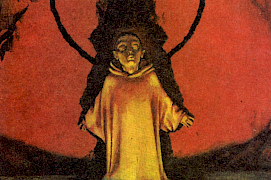
Comrades of the Ring: How Soviet artists evaded censors to create their own visions of Tolkien
Foreign Policy } Joel Merriner
… As noted by Russian scholar Olga Markova, interest in Tolkien’s tale grew quickly behind the Iron Curtain. The first Soviet readers were primarily philologists and translators, individuals who were keen to explore the literary and philosophical elements of the books. For them, The Lord of the Rings offered an escape route out of socialist realist literature into a rich and colorful alternative world.
Soviet authorities, however, were extremely suspicious of what they perceived as a thinly veiled Cold War parable, particularly one that pitched bourgeois country gents (Hobbits), bearded mystics with a suspicious ability to heal ailing royalty (Gandalf), and hereditary monarchs (Aragorn, Théoden, etc.) against an industrialized Eastern nation presided over by an omniscient ruler. Consequently, The Lord of the Rings was barred from publication in the Soviet Union, with any extant English copies of the trilogy consigned to secret KGB holding archives called spetskhrany.
…
It can be tempting to pigeonhole Soviet Tolkien adaptations as weird or comical expressions of a dysfunctional society. But this does them a disservice. Soviet Tolkien was not a sad indictment of communism. It was an example of what was possible when talented, resourceful individuals defied the odds to recreate something they loved. Tolkien, himself, often referred to his fantasy world as a “sub-creation,” namely an imaginary, subsidiary world existing inside of a real one. Soviet Tolkien, with its many variations on the author’s original themes, replicates this in a microcosm.…
❧